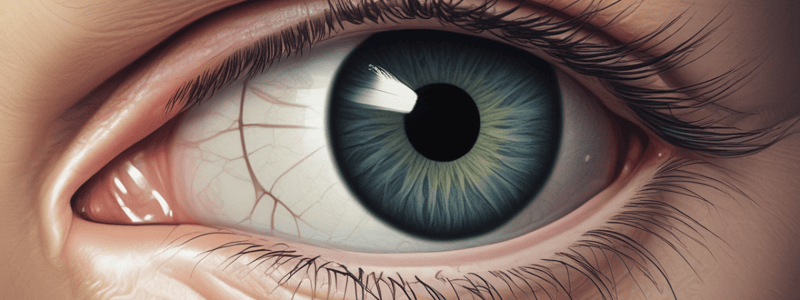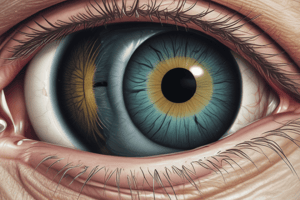Podcast
Questions and Answers
What is the primary function of the superior rectus muscle?
What is the primary function of the superior rectus muscle?
- Abduction
- Elevation (correct)
- Extorsion
- Adduction
Which cranial nerve is responsible for the lateral rectus muscle?
Which cranial nerve is responsible for the lateral rectus muscle?
- 3RD CN
- 6TH CN (correct)
- 4TH CN
- 5TH CN
What is the difference between duction and version?
What is the difference between duction and version?
- Duction refers to the movement of one eye while version refers to the movement of both eyes (correct)
- Duction refers to the movement of both eyes while version refers to the movement of one eye
- Duction refers to vertical movement while version refers to horizontal movement
- Duction refers to horizontal movement while version refers to vertical movement
What is the function of the inferior oblique muscle?
What is the function of the inferior oblique muscle?
Which muscle is responsible for adduction?
Which muscle is responsible for adduction?
What is the type of ocular movement that involves rotation around the anterior-posterior axis?
What is the type of ocular movement that involves rotation around the anterior-posterior axis?
Which nerve is associated with strabismus?
Which nerve is associated with strabismus?
What is the site of nucleus for the superior division of Nerve C N III?
What is the site of nucleus for the superior division of Nerve C N III?
Which muscle is innervated by the superior division of Nerve C N III?
Which muscle is innervated by the superior division of Nerve C N III?
In which structure is the levator aponeurosis located?
In which structure is the levator aponeurosis located?
How many divisions does Nerve C N III have?
How many divisions does Nerve C N III have?
What is the term for the muscle in the same eye that moves the eye in the same direction as the agonist?
What is the term for the muscle in the same eye that moves the eye in the same direction as the agonist?
What is the term for the condition where the brain turns off the visual processing of one eye due to unequal refractive errors?
What is the term for the condition where the brain turns off the visual processing of one eye due to unequal refractive errors?
What type of strabismus is characterized by a nerve palsy?
What type of strabismus is characterized by a nerve palsy?
What is the term for the pair of muscles, one in each eye, that produce conjugate ocular movements in the same direction of gaze?
What is the term for the pair of muscles, one in each eye, that produce conjugate ocular movements in the same direction of gaze?
What is the condition characterized by double vision that persists when one eye is closed and is seen only when both eyes are open?
What is the condition characterized by double vision that persists when one eye is closed and is seen only when both eyes are open?
What is the term for the misalignment of the two eyes?
What is the term for the misalignment of the two eyes?
What is the likely underlying cause of a ⭐ palsy with pupil involvement unless proven otherwise?
What is the likely underlying cause of a ⭐ palsy with pupil involvement unless proven otherwise?
Which of the following structures are innervated by the inferior division?
Which of the following structures are innervated by the inferior division?
What is the primary consequence of damage to the iris sphincter?
What is the primary consequence of damage to the iris sphincter?
Which of the following is NOT a cause of ⭐ palsy mentioned in the text?
Which of the following is NOT a cause of ⭐ palsy mentioned in the text?
What is the likely effect of aneurysm on the inferior division?
What is the likely effect of aneurysm on the inferior division?
Which cranial nerve innervates the contralateral superior oblique muscle?
Which cranial nerve innervates the contralateral superior oblique muscle?
What is a characteristic of the CN IV nerve?
What is a characteristic of the CN IV nerve?
Which muscle is innervated by the contralateral CN IV nerve?
Which muscle is innervated by the contralateral CN IV nerve?
What is the relationship between the CN IV nerve and the superior oblique muscle?
What is the relationship between the CN IV nerve and the superior oblique muscle?
Which of the following statements about the CN IV nerve is FALSE?
Which of the following statements about the CN IV nerve is FALSE?
Flashcards
Inferior Division of the Eye
Inferior Division of the Eye
The part of the eye containing the inferior rectus, medial rectus, inferior oblique, iris sphincter, and ciliary muscle.
Microvascular Ischemia
Microvascular Ischemia
Reduced blood flow in small blood vessels, a possible cause of eye muscle palsy.
Aneurysm
Aneurysm
A bulge in a blood vessel, potentially causing eye muscle palsy, especially with pupil involvement.
Head Trauma
Head Trauma
Signup and view all the flashcards
Agonist
Agonist
Signup and view all the flashcards
Synergist
Synergist
Signup and view all the flashcards
Antagonist
Antagonist
Signup and view all the flashcards
Yolk Muscle (Contralateral Synergist)
Yolk Muscle (Contralateral Synergist)
Signup and view all the flashcards
Amblyopia
Amblyopia
Signup and view all the flashcards
Anisometropia
Anisometropia
Signup and view all the flashcards
Diplopia
Diplopia
Signup and view all the flashcards
Monocular Diplopia
Monocular Diplopia
Signup and view all the flashcards
Binocular Diplopia
Binocular Diplopia
Signup and view all the flashcards
Strabismus
Strabismus
Signup and view all the flashcards
Non-Paralytic Strabismus
Non-Paralytic Strabismus
Signup and view all the flashcards
Paralytic Strabismus
Paralytic Strabismus
Signup and view all the flashcards
Superior Rectus
Superior Rectus
Signup and view all the flashcards
Inferior Rectus
Inferior Rectus
Signup and view all the flashcards
Lateral Rectus
Lateral Rectus
Signup and view all the flashcards
Medial Rectus
Medial Rectus
Signup and view all the flashcards
Binocular Eye Movements
Binocular Eye Movements
Signup and view all the flashcards
Monocular Eye Movements
Monocular Eye Movements
Signup and view all the flashcards
Horizontal Eye Movements
Horizontal Eye Movements
Signup and view all the flashcards
Study Notes
Inferior Division of the Eye
- Consists of IR (inferior rectus), MR (medial rectus), IO (inferior oblique), iris sphincter, and ciliary muscle
- Causes of palsy:
- Microvascular ischemia
- Aneurysm
- Head trauma
- Palsy with pupil involvement is assumed to be secondary to aneurysm until proven otherwise
Muscle Terminology
- Agonist: primary muscle that moves an eye in a given direction (e.g., right lateral rectus muscle in abduction of the right eye)
- Synergist: muscle in the same eye that moves the eye in the same direction (e.g., right superior rectus and right inferior oblique muscles)
- Antagonist: muscle in the same eye that moves the eye in the opposite direction of the agonist (e.g., right medial rectus and lateral medial rectus muscles)
- Yolk muscles (contralateral synergists): pairs of muscles that produce conjugate ocular movements in the same direction of gaze (e.g., right lateral rectus and left medial rectus)
Amblyopia and Strabismus
- Amblyopia: lazy eye, vision deficiency in an eye when the brain turns off the visual processing of one eye
- Anisometropia: unequal refractive errors between the two eyes
- Diplopia: double vision, classified into:
- Monocular diplopia: persists when one eye is closed and seen only when both eyes are open
- Binocular diplopia: seen only when both eyes are open
- Strabismus (Squint/Crossed Eye): misalignment of the two eyes, classified into:
- Non-paralytic (Concomitant Squint): movements of both eyes are full, but only one eye is directed towards the fixated target
- Paralytic Squint: due to nerve palsy
- Restrictive Myopathy
Anatomy of Extra Ocular Muscles
- 7 extra ocular muscles, including:
- Superior rectus: originates from annulus of Zinn, supplied by 3rd CN, functions in elevation, adduction, and intorsion
- Inferior rectus: originates from annulus of Zinn, supplied by 3rd CN, functions in depression, extortion, and adduction
- Lateral rectus: originates from annulus of Zinn, supplied by 6th CN, functions in abduction
- Medial rectus: originates from annulus of Zinn, supplied by 3rd CN, functions in adduction
- Superior oblique: originates from body of sphenoid bone, supplied by 4th CN, functions in intorsion, depression, and abduction
- Inferior oblique: originates from orbital surface of maxilla, supplied by 3rd CN, functions in extortion, elevation, and abduction
- All superior muscles (rectus and oblique) have intorsion, and all inferior muscles (rectus and oblique) have extorsion
Eye Movements
- Binocular eye movements (Versions): prerequisites of binocular single vision
- Monocular eye movements (Ductions)
- Types of ocular movements:
- Horizontal (adduction and abduction)
- Vertical (elevation or depression)
- Torsional (intorsion or extorsion)
Studying That Suits You
Use AI to generate personalized quizzes and flashcards to suit your learning preferences.




